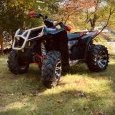By
Sonders
I purchased a super clean 07' Sportsman 800 EFI last year from the original owner with around 700 miles on it, The only thing I haven't liked about it since purchasing was the aftermarket twist throttle they had installed on it. They had it set up for running up and down the road, which was fine for them; but I needed it for a workhorse around the house pulling a bush hog, log splitter and wagon loads of wood. Twist throttle doesn't work too well for my applications. I purchased a oem thumb throttle and cable and installed yesterday. After install the quad will start right up and idles perfectly, but as soon as I give it some throttle it sputters and tries to die. Can bump the throttle hard and fast and it will go, but it tries to sputter still. It's like older style carb that has junk in the fuel line or not getting enough fuel, however I didn't touch anything on it, other than disconnecting the aftermarket cable from the carb and connecting the new one. I checked the points inside the thumb throttle control box (forgot actual name) and they are gapped, so they're not killing it. The only thing I can think of is the throttle position sensor had to be unbolted and pulled off the carb so I could remove the entire carb assembly to gain access to the side of it to remove side cover and unhook old cable and hook up the new cable. I installed it back the exact same way it came off, but could that somehow still have gotten messed up? I have no clue what else to check as I'm not real familiar with these EFI set ups. Any thoughts/help are appreciated. Apparently I should have just left it alone and lived with the dumb twist throttle as it was running perfectly fine.








Recommended Posts
Join the conversation
You can post now and register later. If you have an account, sign in now to post with your account.
Note: Your post will require moderator approval before it will be visible.